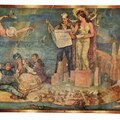
Detail of "The Reduction of Alba Longa” by Giovanni di Ser Giovanni, called Scheggia. Lot 215 of June 8, 2007 Sotherby’s Old Masters Sale of Property of the Albright-Knox Art Gallery, to Benefit the Restricted Endowment for the Purchase of Works of Art.
Sotheby’s research determined both the artist and the subject matter of the previously unkown wooden panel restituted to the Rothschild family after WWII and donated to the Albight Art Gallery in 1948 by Baroness Clarice de Rothschild. Other works by the artist, whose importance was only rediscovered in 1999, are location in: the Metropolitan Museum (NYC), the Ashmolean (London), the Carnegie (Pittsburgh), and the Getty (LA). Scheggia was the younger brother of the famous Massacio, Tomasso di Ser Giovanni.
Sotheby’s identified the subject matter to be from Livy’s History of Rome, Ab Urbe Condita. The abstractly stylized landscape shown here is suggestive of a similar battle scene by Piero della Francesca and of the landscape in Gozzoli’s Procession of the Magi. According to Sotheby’s dating, this panel pre-dated those works. The fact that the importance of this work of art was not establshed until after it was consigned for auction reinforces the perception that the trustees either did not know, or were not interested in, its value. It sold for $540,000.
Sotheby’s Photo
They’re gone. The treasures looted from the “permanent” collection of the Albright-Knox Art Gallery, by the trustees, are now permanently dispersed. Along with those tangible objects, some even more important intangibles have been relinquished: integrity, reputation and authority.
Most major American cities have both a decorative arts museum and a fine arts museum. Buffalo never had a decorative arts museum. As a traditional fine art museum, the eclectic Albright-Knox has had some serious omissions. For example, there is no representation of Mannerism in the collection, in spite of the many provocative parallels that era provided with 20th century modern art.
The collection of 19th and 20th century modern art that was assembled by the Albright-Knox under Gordon M. Smith deservedly brought it great distinction and world renown for its excellence. In the early 1970s, when Robert Buck, Jr. mounted the Sam Francis exhibition, the Albright-Knox was at the height of its international stature and authority as a creative force on the contemporary art scene. It had the authority to make and enhance artistic reputations.
At that time, there was no perceived dichotomy between the traditional art and the modern art in the permanent collection. There was, instead, the firm conviction of a continuity of aesthetic excellence authoritatively connecting aspects of modern art with qualities latent in the art of prior eras.
Sculpture, 3-dimensional gestures of form capturing idea and emotion, has long been a strong point of the Albright-Knox. A stupendous collection of historic sculpture, led by the unspeakable delicate Artemis bronze (sold for $28.5 million), conferred its sound authority on the wealth of modern sculpture in the collection. Artemis enhanced “Big Red.”
Unfortunately, the Albright-Knox chose to stand on the sidelines in the stimulating contemporary exploration of post-modernism. In doing so, its authority in contemporary art was naturally eroded. That was not about money. In the absence of conviction, a false dichotomy emerged to the effect that a choice needed to be made between cultivating the heritage of the older works and seeking excellence in contemporary art.
The wholly unnecessary shift in mission statement, undertaken by the trustees, ironically constitutes an impediment to the goal of regaining the lost prominence and authority. Downsizing the scope of the mission is a dumbing-down of the institution in the sense that it is a reduction of its educational responsibility.
Architect Goron Bunshaft’s masterful design of the Albright-Knox, in its embrace of the old with the new, accurately reflected the permanent collection’s embrace of old and new. The qualities of precision and excellence that pervaded the entire building reflected the strength and authority of the Albright-Knox as an institution.
A mistake of monumental proportions has been made. The group called the Buffalo Art Keepers challenged themselves in a valiant attempt to bring about an amelioration of the damage. Carl Dennis, Katka Hammond, Frank Kowsky, Max Wickert, et al, are a credit to the community and deserve our gratitude for the risks they shouldered.
How can the damage be addressed? It will take more than money or gusto to redeem the wayward muse. It will take acuity of perception, building on the strengths already in the collection. Until the sound of conviction of a continuity of excellence, flowing through the ages to the present, is reestablished, authority will be lacking and the caryatids will seem meaningless.









